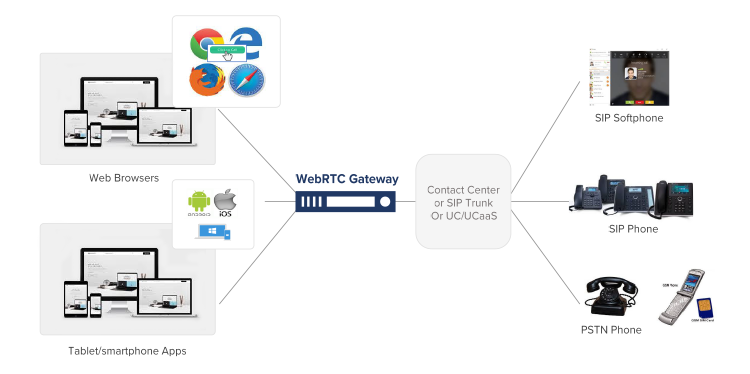In this follow-up post we review the WebRTC gateway as the foundational technology that enables interoperability of the contact center’s SIP components with WebRTC.
Last time, we introduced WebRTC and Why You Need It in Your Contact Center to review the technology’s role in the digital transformation of contact centers, and how web calling improves both the customer experience and enterprise productivity.

Figure 1 - WebRTC Gateway
The WebRTC gateway enables connectivity between a WebRTC-based endpoint and SIP-based applications and endpoints such as:
- a SIP-based contact center application server
- SIP trunking services
- Enterprise UC/UCaaS platform
- SIP phones/softphones
- PSTN phone (via a PSTN gateway).
How does the WebRTC gateway achieve this? The WebRTC gateway mediates and bridges between the WebRTC and SIP protocol stacks. It translates WebSockets-based signaling to plain SIP-based signaling and also converts WebRTC-based (SRTP+DTLS+ICE) media transport to RTP/SRTP transport. While doing so it can also transcode voice codecs from OPUS to G.711.
ENHANCE YOUR CX
SECURE WEBRTC FOR CONTACT CENTERS
In a contact center, a WebRTC gateway is essential for enabling:
- an agent equipped with a SIP phone/softphone to respond to a click-to-call call
- an agent using a web browser (on a PC, a Chromebook, a mobile phone, or a WebRTC-based mobile application) to respond to a call coming from a PSTN phone, regardless of who the PSTN/UC/UCaaS service providers are at either end of the communication.
A WebRTC gateway is also required when centralized control is needed, e.g. for session recording, calling policy enforcement, or conferencing.
Learn more about AudioCodes WebRTC solution for contact centers,

Figure 2 - WebRTC to SIP Interoperability
However, not all WebRTC gateways are created equal. By virtue of bringing voice, video, and unified communications (UC) traffic directly from a web browser via the public internet, WebRTC exposes the contact center to potential attacks such as denial of service (DoS), distributed denial of service (DDoS), fraud or eavesdropping. Any contact center that wants to deploy WebRTC must put in place the necessary measures to eliminate any vulnerabilities to attacks that could potentially be carried via WebRTC traffic.
In our next blog in this series, we will look at how to make the WebRTC gateway resistant to such attacks.
Need Additional Information About our WebRTC Solution? Contact Us.




